|
|
|
Screw Threads and Fasteners |
|
|
|
Screw Threads and Fasteners |
Many precision machined parts are useless until
they are assembled into mechanical
components. These assemblies require the use of many different types of
fasteners. In
this unit you will be introduced to different types of fasteners and their
proper usage.
One of the most fundamental tasks of the machinist is the use of fasteners.
Threaded
fasteners take on many different shapes and forms, but they all have one thing
in common,
the use of a thread. Although threads are used for adjustment purposes,
measuring tool
applications, and the transmission of power, the main use of a thread is as a
fastening
device.
Thread Terminology
Some of the more commonly used thread terms are:
Angle of Thread-
The angle of the thread is the included angle between the sides of the
thread (Figure 1).
For example, the thread angle for Unified Screw
Thread forms
is 60 degrees.
Major Diameter-Commonly
known as the outside diameter (Figure 2).
On a straight
screw thread, the major diameter is the largest diameter of the thread on the
screw or nut.
Minor Diameter-Commonly
known as the root diameter (Figure 2).
On a straight screw
thread, the minor diameter is the smallest diameter of the thread on the screw
or nut.
Number of Threads-Refers to the number of threads per inch of length.
| Pitch-The distance from a given point on one thread to a corresponding point on the next thread (Figure 1). |
|
|
Lead-The
distance a screw thread advances in one revolution. The lead and the pitch
of a single lead thread are the same. On double lead threads, the lead is
twice the pitch. A double lead thread has two start points. |
|
Thread Forms
There are a great number of thread forms. In the later
units of this course, you will examine
these in more detail and you will have the opportunity to cut some threads. As
far as fasteners
are concerned, we will concentrate on the unified screw thread form. The unified
thread form
is an attempt to standardize thread forms in the United States, Canada, and
Great Britain.
Unified threads are divided into the following series:
·
UNC Unified National Coarse·
UNF Unified National Fine· UNS Unified National Special
Unified coarse and unified fine refer to the number of threads per inch on
fasteners. A specific
diameter of bolt or nut will have a specific number of threads per inch of
length. For example,
a ¼-inch diameter unified national coarse bolt will have 20 threads per inch of
length. This
bolt will be identified by the following specifications:
¼-20-UNC
The ¼ is the major diameter and 20 refers to the number
of threads per inch. A ¼ inch diameter
bolt with a fine thread would be identified by the following specifications:
¼-28-UNF
The ¼ is the major diameter and 28 refers to the number
of threads per inch.
The Unified Special Series is identified the same way. A ¼ inch diameter UNS
bolt may have
24 or 27 threads per inch.
You may wonder why there would be a need for UNC and UNF series threads. Here
are some
principal uses of coarse threads and fine thread.
COARSE THREAD SERIES
This series, UNC, is the one most commonly used in the
mass production of bolts, screws, nuts
and other general fastening applications. It is also used for threading into
lower tensile
strength materials (bronze, brass, aluminum, and plastics) to obtain the best
resistance to
stripping of the internal thread. It is also used on quick assembly or
disassembly, or if
corrosion or slight damage is possible.
FINE THREAD SERIES
This series, UNF, when used on external threads has a
greater tensile stress area than coarse
threads of the same size. The fine series will resist stripping out better than
coarse threads in
areas where the external and mating internal threads are subjected to loads
equal to or greater
than the capacity of the screw or bolt. Fine threads are also used where the
length of engagement
is limited or where wall thickness demands a fine pitch.
CLASSES OF THREAD FITS
Some thread applications can tolerate loose threads,
while others require a tighter fit. An example
of this would be the head of an engine. The head of your car or truck engine is
held down by a
threaded fastener called a stud. A stud is threaded on both ends. One end is
threaded into the engine
block. The other end uses a nut to tighten down the cylinder head. When the head
is removed, you
want the stud to remain in the engine block. This end requires a tighter fit
than the end of the stud
accepting the nut. If the fit on the nut is too tight, the stud will unscrew as
the nut is removed.
Unified thread fits are classified as lA, 2A, 3A ... or 1B, 2B, 3B
.... The A indicates an external
thread. The B indicates an internal thread. The numbers indicate the class of
fit. The lower the number
the looser the fit and vice-versa. Class 2 fits are used on the largest
percentage of threaded fasteners.
The tighter the fit the closer the tolerance of the sizes of the thread and
hence the more expensive to
purchase. A typical notation of a unified thread form with fit tolerance would
be:
¼-28 UNF 2A
In this particular case the class of fit would be a 2. The symbol A indicates an external thread.
METRIC THREADS
With the importation and exportation of goods,
especially in the automotive industry, metric threads
have become the prevalent thread type on many kinds of equipment. The metric
thread form is
similar to the unified thread form in that it is based on a 60-degree thread
angle. Metric thread
series take the following form:
M10 X 1.5-6g
Where M is the major diameter in millimeters and the
1.5 is the pitch (distance from one thread to
the next thread) in 1.5 millimeters, the 6 is the class of fit and the "g"
symbolizes the external
thread. This external thread would have a major diameter of 10 millimeters, a
pitch of 1.5
millimeters, and a "medium" thread fit.
THREAD FASTENER IDENTIFICATION
A general definition of a bolt is "an externally
threaded fastener that is inserted through holes in an
assembly." A bolt is tightened with a nut (figure 4). A screw is an externally
threaded fastener that
is inserted into a threaded hole and is tightened by turning the head
(Figure 4).

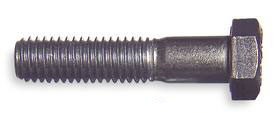

Figure 4 A screw is used in a threaded hole, while a bolt is used with a nut.
From these general definitions a bolt can become a
screw or the reverse can be true. This depends
on how they are used. Bolts and screws are the most common of threaded
fasteners.
The strength of an assembly in large part depends on the diameter of the bolt
or the thread
engagement of the screw. Thread engagement is the distance a screw extends into
the threaded hole.
The minimum thread engagement should be a distance equal to the diameter used;
preferably you
would like to have 1-1/2 times the screw diameter, for it is easier to remove a
broken stud than it
is to drill and tap for a larger screw.
Machine bolts are made with hexagonal or square heads.
The body diameter, the diameter of the unthreaded portion of the bolt below
the head, is typically
slightly larger than the nominal or standard size of the bolt. A hole that is to
accept a bolt must be
drilled slightly larger than the body diameter.
Machine Screws
The machine screw is used for general assembly work. It
is manufactured in both fine and coarse
thread series and fitted with either a slotted or recessed head.
Machine screw sizes vary from No. 0(0.060) to ½ in(0.500) in diameter, and
come in many different
lengths
(Figure 5).
|
|
|
|
|
|
|
|
|
Figure 5 Machine screws |
||
| Carriage bolts are used to fasten wood and metal parts together. Carriage bolts have round heads with a square body under the head. The square part of the bolt, when pulled into the wood, keeps it from turning while you tighten the nut (Figure 6). |
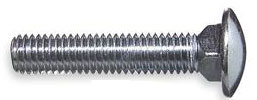 Figure 6 A carriage bolt |
| Cap screws are made with a variety of different head shapes and are used where precision bolts or screws are needed. Cap screws are manufactured to close tolerences and have a finished appearance. Cap screws can have flat heads, round heads, fillister heads, socket heads, and hex heads (Figure 7). |
|
|||||||||
|
|
Set screws are used to lock pulleys, collars, or shafts in place (Figure 8). Socket head set screws usually disappear below the surface of the part to be fastened. Socket head set screws may have hex socket heads or spline socket heads. |
Set screws have several different points (Figure 9).
The flat head set screws are used
where minimal indentation to the part is needed and where frequent adjustments
are made.
They are also used to provide a jam screw effect when a second set screw is
added to
prevent vibrating loose. A dog point set screw is used to hold a collar to a
shaft.
Alignment is always maintained with a dog point set screw because the shaft is
drilled
with a hole of the same diameter as the dog point. A cup pointed set screw will
give a
very good slip resistant connection.
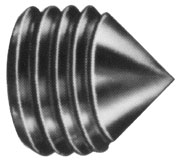 |
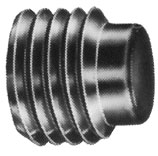 |
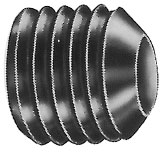 |
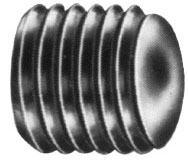 |
|
Cone |
Dog |
Flat |
Oval |
|
Figure 9 Points of set screws |
|||
Bolt Grades and Torque Factors
In some instances bolts need to be fastened with just
the right amount of pressure. In
these instances the manufacturer of certain products will recommend a certain
clamping
force be applied to a particular fastener. Insufficient torque will usually
result in parts
working loose and causing a malfunction due to misalignment. Over tightening, on
the
other hand, can cause stress or warpage, which also might disturb alignment on
assemblies.
The "armstrong" method of tightening fasteners can also cause broken castings,
broken bolts,
or stretching of the fastener.
Steel has excellent elasticity; the ability, like a spring to stretch and
then snap back to its
original shape. Any fastener must reach its limits of stretching in order to
exert clamping force.
But also like a spring, an over stretched fastener takes on set, loses its
elasticity, and cannot snap
back to its original shape. Proper torquing will prevent this condition.
A popping or snapping sound is sometimes heard during the final tightening of
a fastener. This
popping sound indicates that the fastener is undergoing set. When a new fastener
is being used
and the popping occurs, the remedy is to back it off and retighten to the proper
torque
specifications. When an old fastener is being used, and you hear this popping,
take the
fastener out, and clean the bolt and the internal threads out completely. The
safer, more
economical thing to do is to replace the old fastener with a new one.
Cap Screw Grades
|
Just as critical as proper torquing is the selection of the right grade of
fastener for the job. The grades of bolts, or cap screws in figure 10 are identified by the markings on the heads. The grade indicates the strength of the fastener. Use a manufacturer’s chart as a guide for the proper torque of fasteners. |
|
|||||||||
Nuts
Nuts utilize a hexagonal or square head and are used
with bolts with the same shaped head. They are
available in different degrees of finish.
REGULAR is un-machined (except for the threads).
REGULAR SEMI-FINISHED is machined on the bearing face to provide a
straight , flat surface for
the washer.
HEAVY SEMI-FINISHED is the same in finish as the semi-finished;
however, the body is thicker for
greater strength.
CASTELLATED or SLOTTED NUTS have a milled slot across the flats
so they can be locked in
place using a cotter pin or wire.
ACORN NUTS are used when appearance is of the most importance or where
projecting threads
must be protected.
|
WING
NUTS are used when frequent adjustments or
removal are necessary
(Figure 11). |
|
WASHERS
Washers are used to distribute the clamping pressure
over a larger area and to prevent marring. They
can also be used to provide a larger bearing surface for bolt heads and nuts.
Lock Washers
| A lock washer is used to prevent a bolt or nut from loosening under vibration. There are many different types of lock washers. Some of the more common lock washers are pictured in Figure 12. |
|
|||||||||
Non-threaded Fastening Devices
Non-threaded fasteners make up a large group of fastening devices.
Dowel Pins
| Dowel Pins are made of treated alloy steel and are used in assemblies where parts must be accurately positioned and held in absolute relation to one another (Figure 13). They assure perfect alignment and facilitate quicker disassembly and assembly of parts in exact relationships. |
|
Cotter Pins
| Cotter pins are fitted into holes that are drilled crosswise in shafts to prevent parts from slipping or turning off (Figure 14). |
|
Retaining Rings
Retaining rings are stamped rings, both internal and
external, and are used to keep parts from slipping
or sliding apart. While most retaining rings need a groove to seal them in
position, some types are
self locking and do not require the use of a recess.
Keys
A key is a small piece of metal imbedded partially in the shaft and partially in the hub to prevent rotation
of a gear or pulley on a shaft. Here are some different types of keys.
SQUARE KEYS-The width is usually one-fourth of the shaft diameter. One
half of the key is fitted into
the shaft and one half is fitted into the hub
(Figure 15).
GIB HEAD KEY-Except for the gib head, this key
is identical to the square key. The gib head provides
easy removal
(Figure 15).
PRATT & WHITNEY KEY-The ends are rounded and
this key is fitted into a slot on the shaft of the
same shape
(Figure 15).
WOODRUFF KEY-A woodruff key is semi-circular in
shape and fits into a keyseat of the same shape.
The top of the key fits into a keyway in the mating part
(Figure 15).
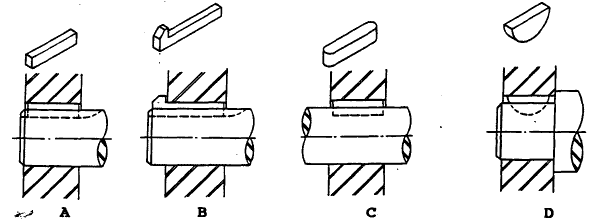
Figure 15
Keys. A-Square, B-Gib head, C-Pratt & Whitney,
D-Woodruff.
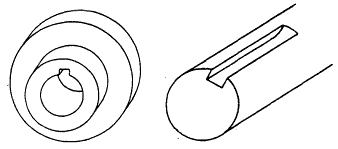 |
|
| Keyway | Keyseat |
Figure 16 A keyway is broached into the hub of the part. A keyseat is machined in the shaft.